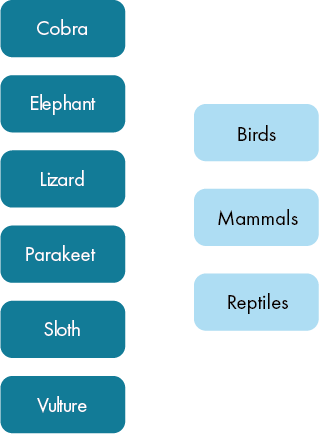Reimagine Learning
Matching, Sorting, and Sequencing
Matching, sorting, and sequencing are worth considering together, because they share the same advantages and disadvantages. Essentially, they are all good item types when used appropriately, but they aren’t appropriate in every context.
Definitions
First, let’s define terms. A matching task asks the learner to connect items from one list with items on another. For example:
Match the country with its capital:

Usually, there are exactly as many items in each list, though these questions can be harder if one side has more than the other.
A sorting task asks the learner to place objects in exactly one of a few categories. For example:
Place each animal in the class to which it belongs. Each animal belongs to exactly one class, but more than one animal may belong to a class.

Usually, there are more items to be placed than there are categories, at least one item in each category, and 2-3 categories, though these are more conventions than hard and fast rules.
A sequencing task asks the learner to place the items in order. These could be steps in a process, items in a timeline, or arranging from smallest to largest. For example:
Place the fractions below in order from least to greatest.

Advantages
Matching, sorting, and sequencing questions can be very good discriminators because they have so many possible responses. A 5-part matching or sequencing item has 5 factorial, or 120, potential responses. There are five potential matches (or places in the sequence) for the first item, each leaving four potential matches (or places) for the second item, each leaving three potential matches (or places) for the third item, each leaving two potential matches (or places) for the fourth item, which leaves one position for the last item. 5 x 4 x 3 x 2 x 1 = 120. With so many possible responses, the chances of getting such a question correct entirely by luck are quite remote.
Also, these tasks provide a welcome break from traditional question types such as multiple choice. Sometimes a change of pace is well worth it, especially for low-stakes practice.
Disadvantages
Here is the bad news: these questions are appropriate only very rarely. Although matching questions can be useful in assessing knowledge of terminology (matching the term with its definition), they are not often used for much else. Most subject matter does not provide much of a reason to match up terms, so matching questions are unlikely to be a substantial part of most assessments.
Sorting involves placing things in categories, which again is relevant sometimes but not all that often. If you look for opportunities to use sorting tasks, you will probably find them, but there aren’t many times when you need to have a sorting task.
Sequencing questions are appropriate even less often. Most subject matter does not involve a distinct order that is worth testing, though math is a notable exception. Sequencing questions can also be used to check that the examinee knows the order of steps in a procedure, but such tasks are usually more a test of memory than anything else.
Scoring
Scoring these questions is a complicated issue. Imagine a ten-part matching question. Suppose an examinee makes 8 correct matches, but botches the last two. Should you award partial credit? Suppose that an examinee answers all ten correctly. What is this performance worth? Should matching questions be weighed more heavily than simple multiple choice questions?
There’s no one simple answer to these questions, which is another reason that these questions are not used often in high-stakes assessments. Still, in the right circumstances, they can measure relevant skills and provide some variety, which is a good thing. Consider using them for low-stakes practice and places in which some interactivity would make a learning experience more engaging. People often like dragging things around and seeing where they fit, and these question types allow you to do that while building relevant skills.
Categories
- Accessibility (5)
- Blog (47)
- E-Learning and Serious Games (16)
- Election Edge (3)
- Guest Blogger (1)
- Learning Design (11)
- News (6)
- Primary Sources (4)
- Remote Learning (3)
- Second Avenue Voices (13)
- Teacher Tools (10)
- Technology (4)
- Uncategorized (9)
- Webinar (11)

